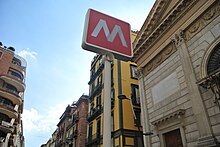
Naples is the regional capital of Campania and the third-largest city of Italy, after Rome and Milan, with a population of 909,048 within the city's administrative limits as of 2022. Its province-level municipality is the third-most populous metropolitan city in Italy with a population of 3,115,320 residents, and its metropolitan area stretches beyond the boundaries of the city wall for approximately 30 kilometres.

Bologna Centrale is the main railway station in Bologna, Italy. The station is situated at the northern edge of the city centre. It is located at the southern end of the Milan-Bologna high-speed line, which opened on 13 December 2008, and the northern end of three lines between Bologna and Florence: the original Bologna-Florence line through Porretta Terme and Pistoia; the Bologna–Florence Direttissima via Prato, which opened on 22 April 1934 and the Bologna-Florence high-speed line, which opened to traffic on 13 December 2009.
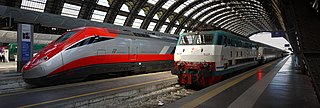
The Italian railway system is one of the most important parts of the infrastructure of Italy, with a total length of 24,227 km (15,054 mi) of which active lines are 16,723 km (10,391 mi). The network has recently grown with the construction of the new high-speed rail network. Italy is a member of the International Union of Railways (UIC). The UIC Country Code for Italy is 83.
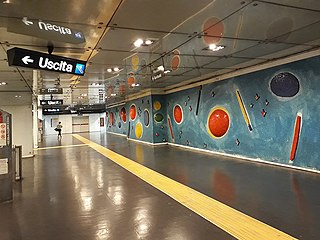
The Naples Metro is a rapid transit system serving the city of Naples, Campania, Italy and some parts of the adjacent comuni of its metropolitan area through Line 11. The system comprises four underground rapid transit lines.
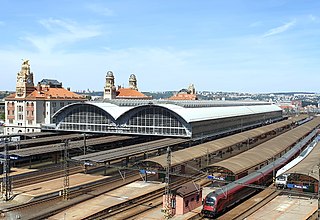
Praha hlavní nádraží is the largest railway station in Prague, Czech Republic.

The Centro direzionale is a business district in Naples, Italy close to the Napoli Centrale railway station. Designed by the Japanese architect Kenzō Tange, the entire complex was completed in 1995. It is the first cluster of skyscrapers to have been built in Italy or southern Europe.

Lamont Young (1851-1929) was a British architect and urban planner from the late 19th and early 20th century — widely noted for a number of prominent buildings in Naples, Italy, his birthplace; his 1906 founding of the Automobile Club d'Napoli; and an ambitious but unrealized urban plan, The Venice District, he conceived for Naples.

Roma Termini is the main railway station of Rome, Italy. It is named after the district of the same name, which in turn took its name from ancient Baths of Diocletian, which lies across the street from the main entrance. It is Italy's busiest railway station and the fifth-busiest in Europe, with a traffic volume of approximately 150 million passengers per year, and with 850 trains in transit per day.

Line 1 is an 18.8-kilometre (11.7 mi) rapid transit line, part of the Naples Metro in Naples, Italy. As of July 2023, Line 1 connects 19 stations. It is operated by Azienda Napoletana Mobilità SpA (ANM). The line has been renamed Metrò dell'Arte reflecting the presence of contemporary art works installed in some of its stations.
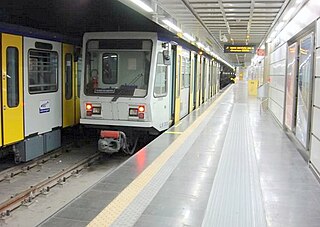
Line 6 is a 2.2-kilometre (1.4 mi) light metro line that forms part of the Naples Metro. It connects 4 stations. The line is currently closed to the public due to low ridership. It has been closed since 2013.
Line 10 is the name of the underground Naples Metro line being built designed to connect the Naples Afragola station of the Rome-Naples high-speed railway with the historic Centre of Naples, with interchanges with Line 1, Line 2, Line 11 and the Circumvesuviana railway. The line itself is designed to be automatically guided (driverless) and connect the municipalities of Afragola, Casavatore, Casoria and Naples, as well as a branch called "Baffo di Arzano" to connect the municipality of Arzano with two stations.

The Naples–Salerno high-speed railway line is a link in the Italian high-speed rail network opened in June 2008. The 29-kilometre-long (18 mi) line is one of the new high-speed lines being built to strengthen rail transport system in Italy and in particular freight and passenger transport in Campania. The line is part of Corridor 1 of the European Union's Trans-European high-speed rail network, which connects Berlin and Palermo.
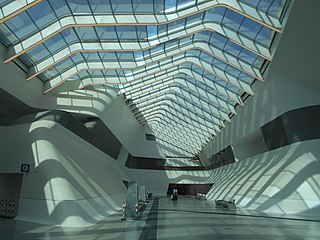
Naples Afragola is an Italian high-speed railway station near Naples that was inaugurated on 6 June 2017, with regular traffic for passengers starting from 11 June 2017. The station is located in the city of Afragola, in the Naples metropolitan area, and was developed to serve all high-speed trains on the Rome–Naples high-speed line, aside from those that do not start or finish at Napoli Centrale station, but instead operate over the Naples–Salerno high-speed line.

Mergellina is a station of the Naples Metro in Naples, Campania, Italy. The platforms serving Line 2 have been active since 25 September 1925, while the one serving Line 6 has been active since 4 February 2007.

The Naples tramway network is located within the city and comune of Naples, in the region of Campania, southern Italy. In operation since 1875, the network has waxed and waned in size and vitality over the years, and is now growing once again. It is now 11.8 km (7.3 mi) long, and comprises three routes, known as lines 1, 2 and 4.

Santa Maria della Verità is a church in rione Materdei, in the quartiere of Stella of Naples, Italy. The entry is located on Via San Agostino degli Scalzi, number 6.
Toledo is a station on Line 1 of the Naples Metro, named after nearby Via Toledo. It won the 2013 LEAF Award as "Public building of the year".

Università is a station on line 1 of the Naples Metro located in the Porto district and part of the art stations.

Materdei is a station on Line 1 of the Naples Metro and is located in Piazza Scipione Ammirato in Naples. According to the British newspaper The Daily Telegraph it was ranked in 16th place as the most beautiful metro station in Europe.

Dante is a station on line 1 of the Naples Metro. It was opened on 27 March 2002 as one-station extension from Museo. The station is located between Museo and Toledo. On 28 March 2011 the line was further extended to Università as non-stop shuttle service, as Toledo and Municipio stations were not yet ready.
